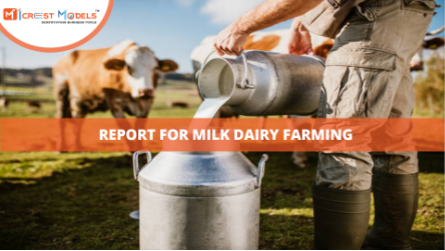In the dairy industry, creating a thorough and insightful project report is essential for securing investment, obtaining loans, or strategizing for business growth. Whether you're launching a new milk dairy project or seeking to expand an existing operation, a well-structured project report can make all the difference. This blog post will guide you through the critical elements of a comprehensive milk dairy project report.
1. Executive Summary
The executive summary provides a snapshot of your entire project. It should be concise yet comprehensive, highlighting the project's purpose, goals, and key financial aspects. Ensure it covers:
- Project Overview: Brief description of the dairy project.
- Objectives: Primary goals and expected outcomes.
- Key Financials: Estimated costs, revenue, and profitability.
2. Project Background
Provide a detailed background of your project. This section should include:
- Industry Overview: Current trends, market size, and growth potential in the dairy industry.
- Project Rationale: Reasons for choosing this project and its significance.
- Location Analysis: Details about the project's geographical location, including the benefits of the chosen site.
3. Detailed Project Plan
This section should outline your operational plan in detail, including:
- Product Line: Types of dairy products to be produced (milk, cheese, yogurt, etc.).
- Production Capacity: Estimated production volumes and capacity utilization.
- Process Flow: Step-by-step description of the production process from raw milk collection to finished products.
- Technology and Equipment: Types of machinery and technology to be used.
4. Market Analysis
Conduct a thorough analysis of the market to understand your target audience and competition. Include:
- Target Market: Identification of potential customers and their demographics.
- Market Demand: Analysis of current demand and future growth prospects.
- Competitive Analysis: Overview of main competitors, their strengths, and weaknesses.
5. Marketing Strategy
Detail your strategy for reaching your target market and driving sales. Consider:
- Pricing Strategy: Pricing model and factors influencing pricing decisions.
- Distribution Channels: Methods for distributing your products (direct sales, retail partnerships, online platforms).
- Promotion and Advertising: Plans for advertising and promoting your dairy products.
6. Financial Plan
A robust financial plan is crucial for assessing the viability of your project. This should include:
- Initial Investment: Breakdown of startup costs, including land, building, equipment, and working capital.
- Operating Expenses: Ongoing costs such as raw materials, labor, utilities, and maintenance.
- Revenue Projections: Expected sales volumes, pricing, and revenue forecasts.
- Profitability Analysis: Projected profit margins, break-even analysis, and return on investment.
7. Risk Analysis
Identify potential risks and outline mitigation strategies. Consider:
- Market Risks: Fluctuations in demand, price volatility.
- Operational Risks: Equipment failures, supply chain disruptions.
- Financial Risks: Interest rate changes, funding shortfalls.
8. Sustainability and CSR
Highlight your commitment to sustainability and corporate social responsibility (CSR). Include:
- Environmental Impact: Measures to minimize environmental footprint, waste management practices.
- Social Responsibility: Initiatives to support local communities, fair trade practices.
9. Implementation Plan
Provide a roadmap for project implementation with a clear timeline. Include:
- Milestones: Key phases and milestones in the project development.
- Resource Allocation: Allocation of resources and responsibilities.
- Project Management: Methods for monitoring progress and ensuring timely completion.
10. Appendices
Include any additional information that supports your project report:
- Technical Specifications: Detailed specifications of equipment and technology.
- Supporting Documents: Licenses, permits, certifications.
- References: Any references or citations used in the report.
Conclusion
Creating a comprehensive milk dairy project report requires thorough research, meticulous planning, and detailed documentation. By following this guide, you can ensure that your report covers all critical aspects, providing a solid foundation for the success of your dairy project.





Comments